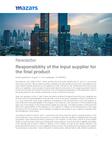
Responsibility of the input supplier for the final product
According to Law 1480 of 2011, which contains the Consumer Statute (the "E. del C."), consumers and users have the right to receive quality, suitable and safe goods and services. Correlatively, the same statute obliges producers and suppliers to offer and put on the market products that comply with such qualities, under penalty of being liable before consumers for the legal guarantee thereof, jointly and severally among each and every one of the agents participating in the production chain of the good placed on the market or delivered in favor of the final consumer.
Now, the regulation of the E. del C. does not define whether the agents bound by such solidarity are all those who have participated in the production chain of the good, regardless of their contribution to it, or only those who have made a decisive contribution to the achievement of the final product, or only those who have participated in the supply of the material or the execution of the procedure that gave rise to the defect of the product that enables the warranty. The determination of this point will define the responsibility of the suppliers of raw material in relation to the effectiveness of the legal warranty of the final product, due to defects unrelated to the quality of such material, a problem that we will address in this article.
According to article 3 of the E. del C., consumers and users have the right to a quality product, in the sense that they must "receive the product in accordance with the conditions established by the legal guarantee, those offered and those customary in the market". In this sense, article 6 of the statute reaffirms what has been said, by providing that "every producer must ensure the suitability and safety of the goods and services it offers or places on the market, as well as the quality offered", and prescribes that the breach of such obligation will give rise to "joint liability of the producer and supplier for warranty to consumers". Up to this point, it seems clear, without further ado, that the producers and suppliers participating in the chain of production and placement of a good shall be jointly and severally liable for the predictable defects thereof, through the figure of the legal guarantee.
Now, let us consider the following scenario: Cueros S.A.S. supplies leather to Ensamblaje de Piezas S.A., which also receives fasteners from Abrochamiento Ltda. In turn, Ensamblaje de Piezas S.A. transforms the leather, zippers and other inputs it receives from third parties into bags, wallets and boots, for the benefit of Marca Conocida S.A.S., which simply attaches pieces indicating its brand to these products, and then sells them wholesale to traders who place them on the market in their commercial premises for sale to the end consumer.
In a first variant, let us consider the case in which the bags sold to consumers fall apart when in contact with water due to a defect in the raw material provided by Cueros S.A.S. In this hypothesis, it is clear that solidarity should be predicated without any inconvenience between the retailer, Marca Conocida S.A.S., Ensamblaje de Piezas S.A. and Cueros S.A.S., but should it also proceed with respect to Abrochamiento Ltda. In a second variant, let us consider the case in which the seams of the boots give way prematurely with the consumer's use as a consequence of an error exclusively predictable of Ensamblaje de Piezas S.A. during the production process of the final product. Regarding this hypothesis, it is clear that solidarity should be peacefully predicated between the retailer, Marca Conocida S.A.S. and Ensamblaje de Piezas S.A., but should it also proceed with respect to Abrochamiento Ltda. and Cueros S.A.S., companies that in no way intervened in the process in which Ensamblaje de Piezas S.A. erred?
We consider that the cases raised admit several positions:
On the one hand, it could be stated, simply, that where the law does not distinguish, its applicator should not do so, reason for which, all must respond. Thus, in both cases, all those involved would be liable regardless of the amount of their contribution.
This position, beneficial for the consumer, would entail an unreasonable risk for businessmen.
On the other hand, it could be argued that the product placed on the market is a bag and not leather, and that, to the extent that the warranty will be predicated on the product, only those agents who participated in the production or placement chain in question will be liable, starting from the existence of the product, without prejudice that they can repeat or call as warranty the suppliers of raw material, in case the defect is based on the breach of their contractual obligations.
Thus, to the extent that the bag exists on the occasion of the activity of “Ensamblaje de Piezas S.A.S.”, it is this and the intervening parties downstream to the retailer, who will be jointly and severally liable for the warranty of the product.
This position, while limiting the linkage, is more reasonable and beneficial to entrepreneurs and the economy.


